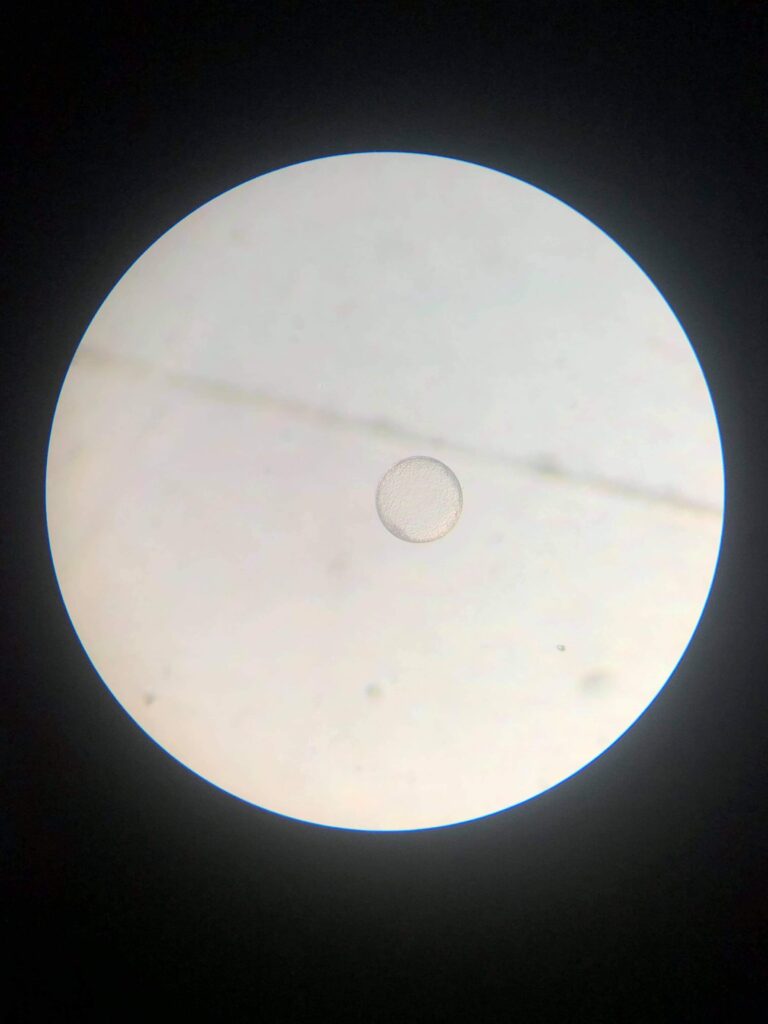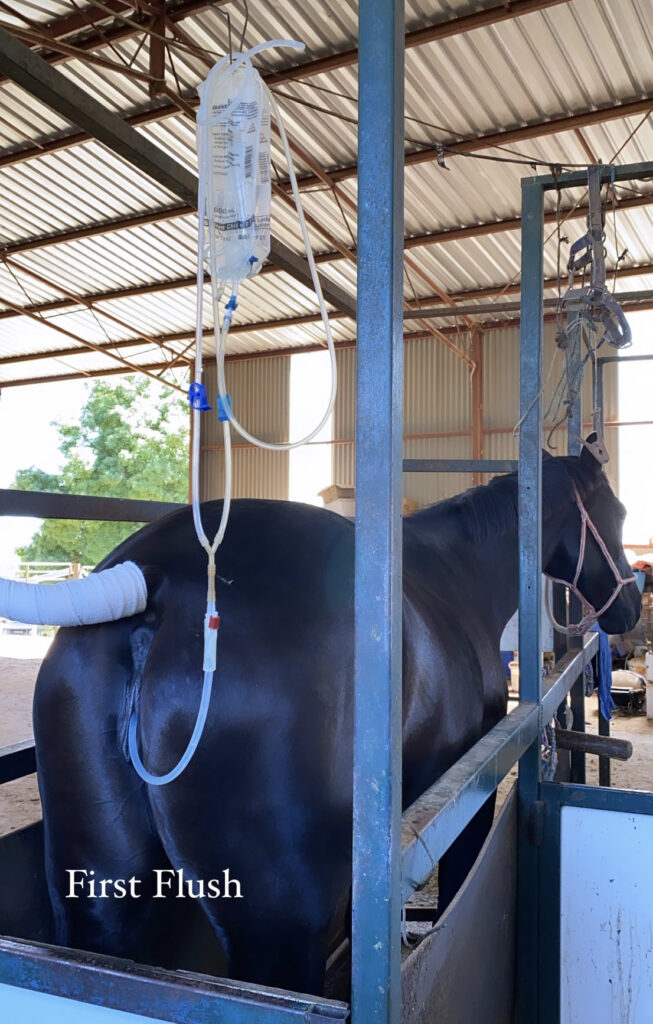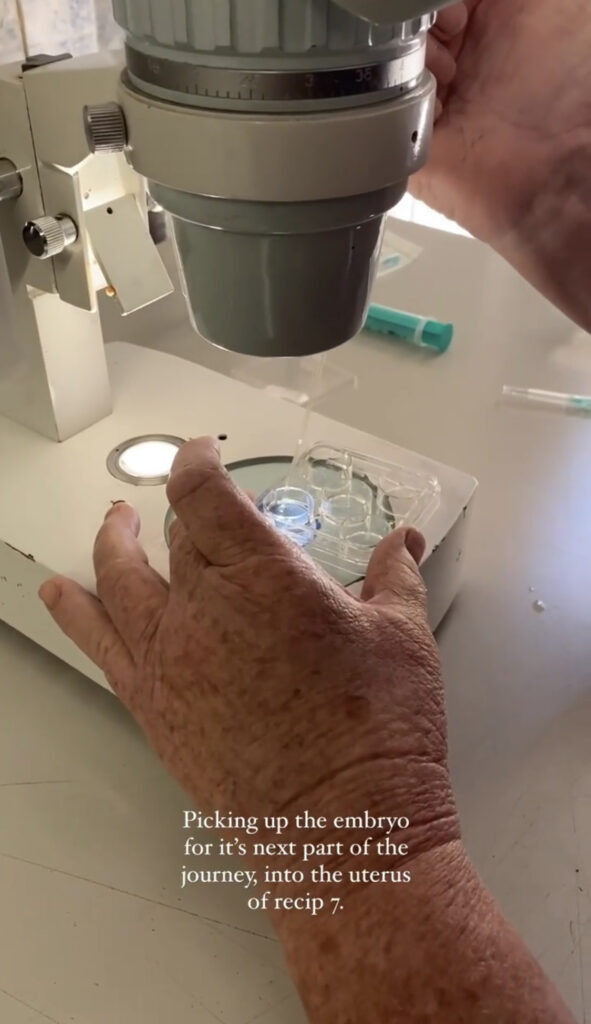The process of equine embryo transfer involves the collection of the embryo through flushing the donor mare. The resulting embryo is then implanted into another mare, (the recipient). This process is called the Transfer. The donor mare is bred as if she were to carry her natural foal. This can be done through natural service or A.I. (from chilled or frozen semen). The recovery of the embryo involves passing a catheter through the cervix and irrigating fluid through the uterus. The fluid then passes through a filter for embryo retrieval. Ovulation day is termed Day 0, and flushing takes place on day 6 or 7. The recipient mare, (who has not been bred), should have ovulated ideally on the same day, or within 1 day of the donor mare. Once the embryo has been located and graded under the microscope, it is washed and loaded, and then transferred into the recipient mare.
Some of the advantages of embryo transfer include, mares that are actively in competition may still be used for breeding purposes. Usually it is these elite mares that are left until they retire before breeding, and therefore cutting short their reproductive life. Further advantages include the possibility to gain multiple pregnancies in a single year, thus enhancing the genetic contribution of the donor mare. Young, potentially exciting mares, can also be flushed allowing breeders to access their genetics somewhat earlier than they would in a natural situation.
Naturally, embryo recovery is best from young, fertile mares in good condition, and 70 – 80% of flushes will yield a viable embryo. Older, less fertile mares with problems can be less than 20%. It is very important that the recipient mares be of high reproductive quality, in good condition and have a nice disposition with an even temperament. The fertility of the stallion used, remains an important influence in the production of a viable embryo.
The process of embryo recovery and transfer is an intensive, costly and complicated process. The advantages of artificially reproducing your elite mare must be weighed against the costs involved in completing this process. Maintenance of the recipient herd is considerable, with some mares being kept and not used in 2-3 years, and being constantly screened for follicles and soundness. There is considerable experience needed to successfully flush and transfer these embryos, as well as being able to synchronize the recipient mares with the donor. Unlike cattle, mares will usually only release one egg per cycle, so to gain multiple pregnancies from your mare requires multiple flushes. For the best results, it is preferable to have the stallion and mare housed at the same location, however with the advances in chilled semen, and frozen semen, distance can be over come.
Berragoon Equine Breeders uses the Holbrook Vet Centre for all its embryo transfer and artificial breeding. Dr Reon Holmes and Dr Carlie Schmidt have extensive experience in bovine E.T. and over the last two seasons, they have developed considerable skills in equine E.T. with excellent results. At present, embryo retrieval stands at 80%, with pregnancies holding at 70%, making it a viable option for breeders wanting to be at the forefront of the industry. At “Mandaring” a 45 head recipient herd is run, made up of young thoroughbred, Standard bred, and Stock Horse Mares, primarily under the age of 6 years. These mares are constantly teased and scanned for follicles, to be used in a program with a donor mare.
Synchronisation of Donor with Recipient Mares
This is the co-ordination of ovulation time between the donor and her recipient, through the use of drugs, teasing and ultra-sound scanning.
Breeding through Artificial Insemination or Natural service of the Donor Mare
The donor mare can be either A.I.’d using frozen, chilled, fresh semen, or natural service. * *(The client will be responsible for any costs involved with semen collection and/or shipment, and service fees.)
Flushing of the Donor Mare
The physical flushing of the donor mare with the placement of a catheter into the uterus through the cervix, and then the gentle manipulation of fluid in and out of the uterus, after which the fluid passes through a filter, where the embryo is recovered.
Embryo Recovery and Transfer
After the embryo is located under the microscope, it is washed, graded and loaded, ready for transfer into the recipient.
Pregnancy scanning of the Recipient Mare
A flush and transfer will be deemed successful on a 45 day pregnancy scan. Scans will also be carried out around days 14 and 23 of the pregnancy. Fees inclusive up to and including the 45 day pregnancy scan.
Recipient Options
Clients may lease the recipient mare from B.E.B. In the case of a mare being leased, the client will be responsible for any vet fees, agistment, drenching and other expenses incurred by the recipient mare whilst pregnant and/or in their care. The client will also be responsible for the transportation of the recipient mare back to “Mandaring” at the expiry of the lease.
Clients may also take up the option to purchase the recipient mare carrying the pregnancy from their donor mare by arrangement. The client will be responsible for any vet fees, agistment or other expenses incurred by the recipient after the successful 45 day pregnancy test.




